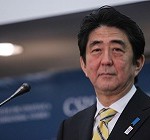In elections held on July 21, Japan’s Liberal Democratic Party (LDP), led by Prime Minister Shinzo Abe, convincingly won 115 of the 242 seats in the upper house of the National Diet, the national legislature. The victory gives the LDP a three-fold dominance: the seat of the prime minister and control of the two houses of government.
A realignment of this kind is significant, given Japan’s status as the world’s third largest economy. But in terms of geopolitical manoeuvring, the significance is amplified in important ways worth investigating.
Victory has made it possible to fulfil Abe’s plan to alter the Japanese Constitution. This is a hawkish move, but has growing resonance in Japan in recent years. The plan is in three phases. Phase One was sealed during Abe’s first term, which started in September 2006 and ended a year later. He fought for, and passed, the National Referendum Law. This put in place a mechanism that will make an eventual public rubberstamping of an amendment an inevitability. Phase Two was control of the legislature, and the LDP now dominates both houses.
Phase Three is Constitutional revision: editing and renaming the Renunciation of War chapter, delineating a National Defence Force under the leadership of the prime minister, and even restoring the Rising Sun national flag alongside the country’s traditional anthem.
As a punishment for aggression during World War II, United States-led occupying forces imposed severe restrictions on Japan on the use of its military force for combat. Now, for the first time in 70-plus years, the political stars in Japan may be aligning to enable the dismantling of these restrictions. With changes to the Constitution, Japan can transform its role in world affairs, with a large, reconstituted and technologically advanced defence force.
Japan’s potential rearmament is also driven by other factors. For example, the U.S. is asking Japan to become an active participant in its efforts to contain China. This was evident in extensive joint military training exercises (called “unprecedented” and “historic”) off the coast of California in the last four months. The simulated island and coastal invasions were clearly meant to send a message to China.
China will not take a rearmed Japan lightly, especially when relations between the two countries are already at a low. Responding to Abe’s defence-related statements, highlighted by Japan’s first increase in military spending in 11 years, China issued the following statement:
“In a short term, Abe may benefit from catering to the rightists, but in the long run, what he has done is equivalent to playing with fire…In recent years, it is irresponsible remarks and deeds made by Japanese leaders that had flamed up [these] rightists. However, one day in the future, when [their views] expand to an uncontrollable scale, Tokyo would have to eat the bitter fruit. What’s worse, innocent and peace-loving people would bear the consequences.” [1]
But Abe faces hurdles that may put his plans in jeopardy. His party has won control, but not a majority, of the upper house (with 115 of the 242 seats). Although coalitions give the party majority control, the numbers still leave him short of the two-thirds needed for Constitutional reform. This is germane, considering that the LDP’s coalition partner, the New Komeito Party (which holds 20 seats), has come out strongly against Abe-style defence proposals. The Nippon Ishin No Kai (Japan Restoration Party) may be a more suitable collaborator, though their nine seats fail to make them a relevant major player.
So far, the self-named Abenomics programme has been a winning formula that has trumped the opposition, but this may not necessarily hold true on Constitutional changes. Besides, Abe may have touched some notes that resonate with the public, but public opinion diverges on key issues. For example, the majority of people are against restarting the country’s now-idle nuclear industry. The majority do not even favour the change in the Constitution.
Abe’s ability to find a coalition partner that moves his current agenda forward has implications for India. Japan and India are cooperating on a number of high-stakes projects, including the financing of transportation infrastructure in several parts of India, a nuclear agreement which will facilitate the construction of 18 Indian reactors by 2020, and a security deal recently inked in the wake of Chinese border infractions. With the bilateral relationship now seemingly fortified by a unified legislature, Indian-Japanese projects and plans are likely to proceed even sooner.
Will a firm coalition come together to back Abe’s ambitious policies? The elections results might suggest that it will, but the conscience of the people indicates otherwise. Or will a new face of Japan precipitate a conflict of unpredictable dimensions?
Michael Burns, Ph.D. is a university instructor and documentary film maker whose work focuses on political issues involving military conflict as well as perceptions of democracy. He is based in Mumbai.
This article was exclusively written for Gateway House: Indian Council on Global Relations. You can read more exclusive content here.
For interview requests with the author, or for permission to republish, please contact outreach@gatewayhouse.in.
© Copyright 2013 Gateway House: Indian Council on Global Relations. All rights reserved. Any unauthorized copying or reproduction is strictly prohibited.
References
1. Liming, W. (2013, July 10). Japan runs risk of playing with fire.People’s Daily Online. Retrieved from http://english.cpc.people.com.cn/206972/206974/8320386.html


